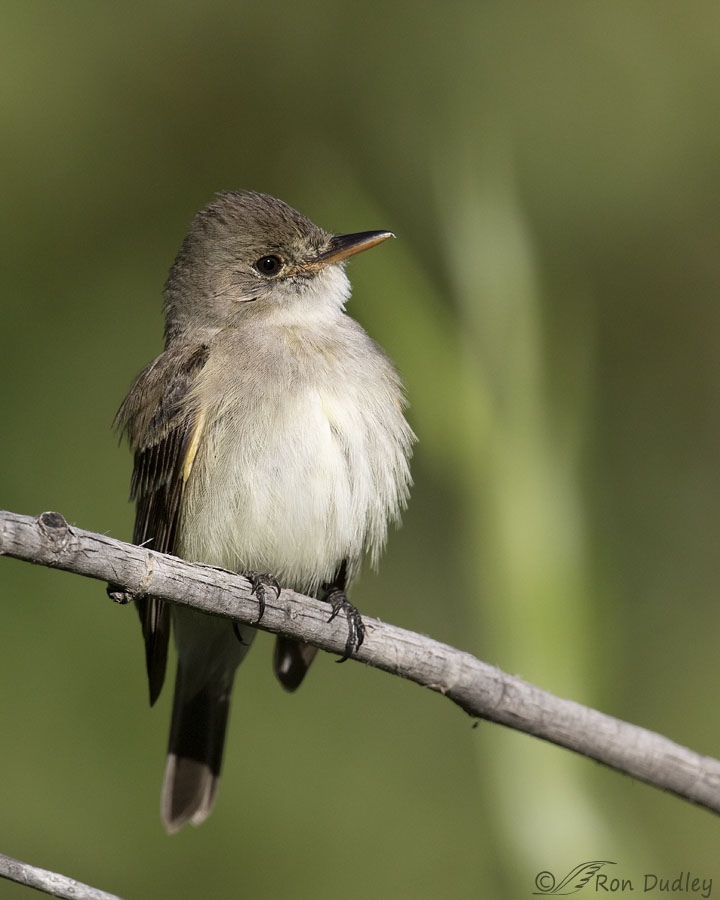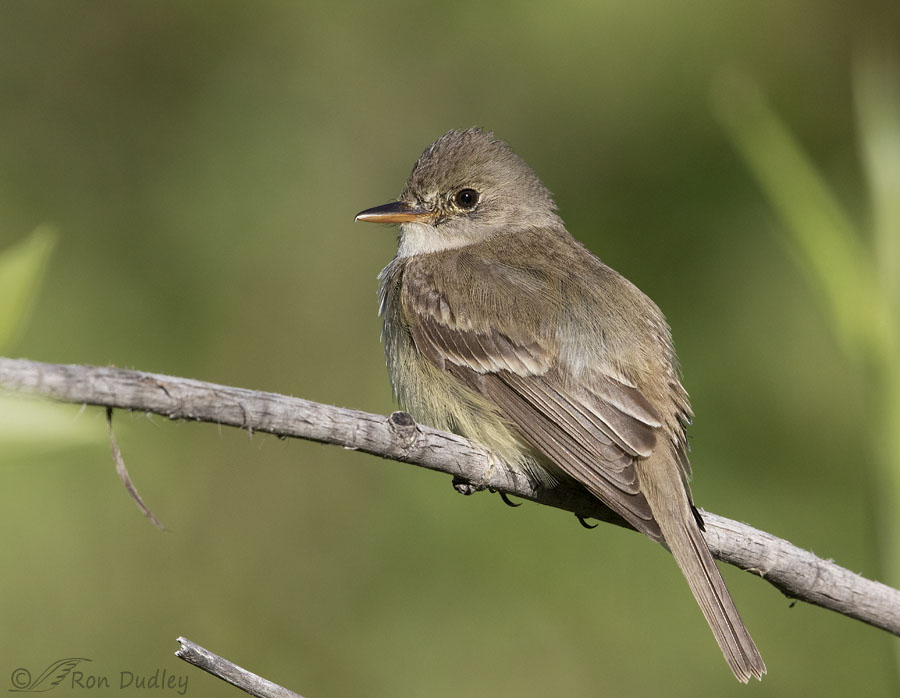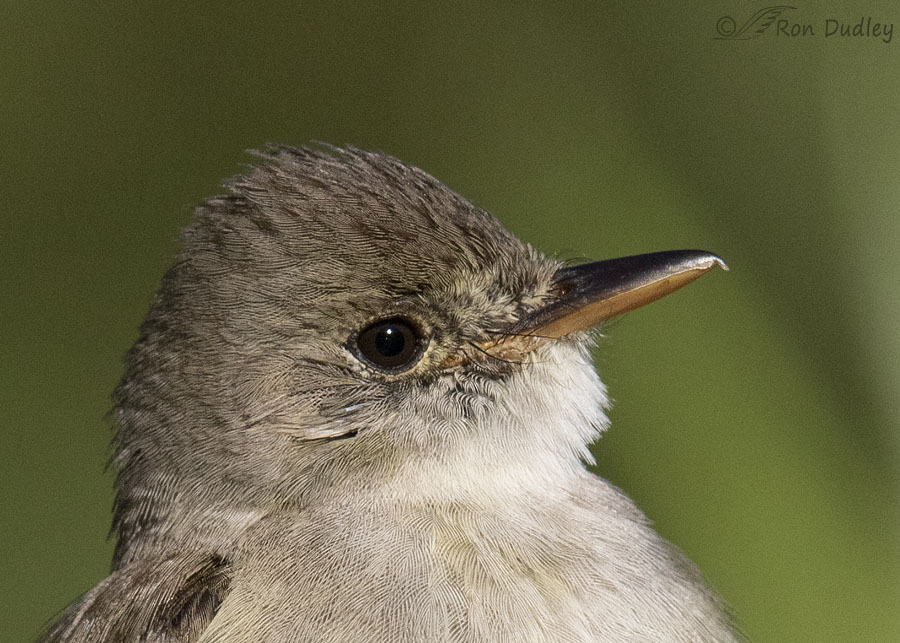While photographing this flycatcher I did what I didn’t do with yesterday’s catbird. It actually worked.

1/5000, f/6.3, ISO 800, Canon 7D Mark II, Canon EF 500mm f/4L IS II USM + EF 1.4 III Extender, not baited, set up or called in
I know this particular branch to be this flycatcher’s favorite perch but when I position myself to photograph him if he lands here I have less chance with other birds so I usually park my pickup elsewhere. But two days ago I decided to give it a try for a few minutes and sure enough, he landed in a clear spot on the branch in good light and posed nicely for me. He was even close enough that in this pose I felt I had to shoot vertically in order to give me enough room in the frame for the best possible composition.

1/2000, f/9, ISO 800, Canon 7D Mark II, Canon EF 500mm f/4L IS II USM + EF 1.4 III Extender, not baited, set up or called in
Soon he turned around on the perch and gave me a pose that allowed me to shoot horizontally again.
Do you remember the catbird photo I posted yesterday whose tail was extremely out of focus because I was using my default camera settings (f/6.3 in particular) to give me oodles of shutter speed? Notice that the same thing happened in the first shot above, the tail is soft at f/6.3 because of insufficient depth of field. So when this flycatcher turned around on the perch and looked like he would stick around for a while I decided to risk it and take the time to change my aperture to f/9 and then refocus on the head of the bird.
It worked! Even though in both shots the tail appears to be about the same distance from the plane of my point of focus (his head) the tail is sharp in the second photo while it isn’t in the first. There were other variables involved too (distance from subject for example) but I’m convinced that in this case it was my aperture setting that made the difference.
It’s nice to see “theory” pan out in the field.

I’ll close by doing what I often do – include a highly cropped version of one of my post photos to show interesting detail. Here we see two flycatcher adaptations, the hooked bill that makes capturing insects on the wing much more efficient and the rictal bristles originating near the gape of the bird’s mouth.
For years it was thought that rictal bristles function as a sort of physical trap or net to allow birds to more efficiently scoop up insects as they foraged through the air but today the consensus among ornithologists seems to be that the real function of rictal bristles is sensory, letting the bird know its speed and orientation in the air.
Our knowledge of birds marches on.
Ron
Correction: In researching this post I found several recent sources that stated or strongly implied that the “consensus” among researchers is that the primary function of rictal bristles is sensory. But based on comments from others and additional research after I arrived home from shooting this morning it’s not as clear cut as that. Apparently there still is no consensus on their function.


Marvelous series Ron!
Charlotte
There is something I’m finding viscerally exciting about the vertical shot. I keep scrolling back up to it. Wow! I also really like the portrait for the feather detail and chance to look at that raptor-like tip of his beak.
That vertical is my favorite too, Marty. Some folks shy away from posting verticals because some people don’t like vertical compositions but when they’re appropriate I like them a lot.
Education AND beauty. Thank you teacher. I am glad that you also found the rarity of a co-operative bird too.
Thank you, EC.
Learned a lot today thanks to all!
Great photos too, who could ask for more?
Thanks, April.
I have learned a lot from everyone today. Thank you all.
Rectal bristles, hooked beaks, photographic techniques: indeed, thanks to you and commenters our knowledge marches on daily.
Thanks, Lyle. Yes, we owe a lot to the commenters, as usual.
I’d like to add that there are other feathers similar to bristles but much longer and more flexible that are called filoplumes. There is sometimes a very small tuft of vane at the tip. These are mostly found around the nape and back of the head and between the flight feathers of the wing. Sensory cells at the base of the filoplumes provide information about speed, wind, etc. These are very difficult to see unless you have a bird in the hand and deliberately spread other feathers to look for them. If some rectal are in fact tactile, they provide idfferent information than do the filoplumes.
Yes, I used to teach my zoology students about filoplume feathers.
And congrats, Dan – looks like you’ve solved the problem of your comments not going to the top!
Rictal bristles are mostly found around the base of the mouth. The gape is called the rictus and from this, the bristles get their name. These are specialized feathers with no vane, just a shaft. Experiments, including those on Willow Flycatchers, show no function in food capture, as you have said. But, they also were not shown to be sensory in function in these birds. Insect capture is with the tip of the bill and the rictal bristles play no role in experimental work done. And no sensory role was also found. Instead, it appears that these bristles helped to protect the eye. Large insects with long legs or insects missed in a strike often came near the eye and were deflected by these bristles. Some people have also suggested that they may also deflect and redirect an insect toward the beak in the case of a near miss,
Much work remains to be done about understanding the role of these bristles, however. Many non-insectivorous birds also have rictal bristles of the same size and placement and we don’t fully understand their function. In at least some owls sensory cells have been found at the base of these bristles, providing sensory information as the bristle is moved, but this may not be the case in all birds and more study in needed.
Thanks very much for fleshing all that out, Dan. There’s lots of conflicting info on the web regarding rictal bristle function so I tried to find some of the newer stuff. At least two sources said or implied that the consensus among researchers was sensory so I went with it. Nice to get your apparently more current information.
Lovely bird and GREAT biological and photography information! Going to F9 certainly didn’t create background issues in this case….
Going to F9 certainly didn’t create background issues in this case….  I would have never known about the hook on the end of the beak nor the rictal bristles. Luv Ken’s comments on the rictal bristles vs. the Boeing 737 MAX! (giggle). Noisy around here the past day or so. Swallow chicks from under the bridge have fledged and they are everywhere flying and/or covering a good portion of the power line across the creek hollering to be fed…
I would have never known about the hook on the end of the beak nor the rictal bristles. Luv Ken’s comments on the rictal bristles vs. the Boeing 737 MAX! (giggle). Noisy around here the past day or so. Swallow chicks from under the bridge have fledged and they are everywhere flying and/or covering a good portion of the power line across the creek hollering to be fed…  Wish they’d do a bitter job on the mosquitos tho I’m sure they’re helping!
Wish they’d do a bitter job on the mosquitos tho I’m sure they’re helping!
“Going to F9 certainly didn’t create background issues in this case”
In this case it didn’t, Judy. But if the background had been closer it certainly could have. That’s another thing the photographer has to keep in mind when choosing aperture.
Ron, Approximately at what distance were the first two photos taken ?
Gary, I stepped off what looked like the proper distance and then measured it. My best guess is that the bird was 18 – 19′ from the end of my lens. The highly cropped version of the first photo is cropped to 7.5% of the original image (1.5mp of 20mp).
Beautiful photos…each of them. These are one of the sweet little guys I love to watch…the way they zip out and return back to their perch, occasionally hearing the snap of the beak as they scoop up a snack. Just looking at the detail that is visible in the feathers in the cropped picture is phenomenal; that separation in the feathers…wow. Also interesting how f/9 does not give full clarity of the entire branch, just directly around the bird…love how those numbers work. So much to learn…
Good eye in noticing how focus falls off in both directions on the perch. Thanks, Kathy.
if that head shot doesn’t make you love digital technologies–modern digital photo gear in particular–nothing will.
I heartily agree, James. I love looking at fine detail like that – image quality be damned.
Rictal bristles definitely new knowledge for me. Nice photos and good that your decision to wait and watch that perch worked.
Sometimes plans and intentions actually come to fruition, Everett. Even for me…
Well Ron, I learned something new this morning, not unusual when I read your posts. I’m sure that those rictal bristles work better than their counterparts on Boeing’s 737 MAX! At least both sides are activated in case one fails.
That made me smile, Ken. I’m sure you’re right.